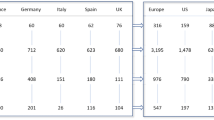Conclusions
This review of the results of electric shock therapy permits the following conclusions:
-
1.
The results of such treatment of patients with dementia præcox, measured in terms of recovery and much improvement, are not so good as corresponding results with groups of patients treated with insulin.
-
2.
The results are more favorable than those produced by metrazol.
-
3.
Rates of recovery and of improvement among patients with dementia præcox following electric shock therapy are superior to those shown by control series.
-
4.
Electric shock is especially efficacious among patients with manic-depressive psychoses and involutional disorders.
Similar content being viewed by others
References
See for example, Malzberg, Benjamin: Social and Biological Aspects of Mental Disease, Chapter XIV. State Hospitals Press. Utica, N. Y. 1940.
Pollock, Horatio M.: Mental Disease and Social Welfare. Chapter XII. State Hospitals Press. Utica, N. Y. 1941.
See reference 2, page 175.
Author information
Authors and Affiliations
Rights and permissions
About this article
Cite this article
Malzberg, B. The outcome of electric shock therapy in the New York Civil State Hospitals. Psych Quar 17, 154–163 (1943). https://doi.org/10.1007/BF01572739
Published:
Issue Date:
DOI: https://doi.org/10.1007/BF01572739




